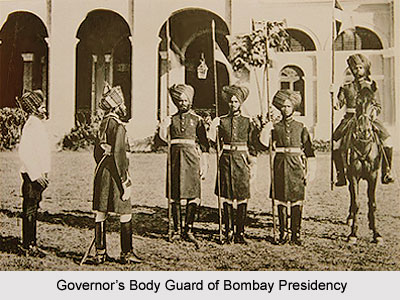 The Governor`s Body Guard of Bombay Presidency, also known as Governor`s Bodyguard Bombay, was a British Indian Army Regiment. It was founded in 1865 and was disbanded in the year 1947. The British army in India established three separate body guard regiments for the 3 main Presidencies in British India, namely, the Bengal Presidency, the Bombay Presidency and the Madras Presidency. The body guard units were named as Governor`s Body Guard. The Governor`s Body Guard of Bombay Presidency was a part of the Bombay Army, before the Sepoy Mutiny in 1857. The military of Bombay Presidency was one of the 3 most prominent Presidency Armies in British India. The Army of the province of Bombay was greatly involved in the defeat of Tipu Sultan, the ruler of the Sultanate of Mysore. Later the Bombay Army participated in many other campaigns, including the First Anglo Afghan War.
The Governor`s Body Guard of Bombay Presidency, also known as Governor`s Bodyguard Bombay, was a British Indian Army Regiment. It was founded in 1865 and was disbanded in the year 1947. The British army in India established three separate body guard regiments for the 3 main Presidencies in British India, namely, the Bengal Presidency, the Bombay Presidency and the Madras Presidency. The body guard units were named as Governor`s Body Guard. The Governor`s Body Guard of Bombay Presidency was a part of the Bombay Army, before the Sepoy Mutiny in 1857. The military of Bombay Presidency was one of the 3 most prominent Presidency Armies in British India. The Army of the province of Bombay was greatly involved in the defeat of Tipu Sultan, the ruler of the Sultanate of Mysore. Later the Bombay Army participated in many other campaigns, including the First Anglo Afghan War.
These units were under the administrative rule of the British East India Company until end of the Sepoy Mutiny of 1857. The control of the British Presidency Armies was reassigned to the British Empire in India from the British East India Company after the Government of India Act 1858 was authorized. The Presidency Armies, namely the Bengal Army, the Madras Army and the Bombay Army, were later united to raise the combined British Indian Army in the year 1903.
History of Governor`s Body Guard of Bombay Presidency
The Governor`s Body Guard of Bombay Presidency was founded in Poona (now Pune) on 22 March 1865. It initially consisted of a selected structure of cavalrymen of the dissolved unit The Southern Mahratta Horse (SMH) that was formed in 1850. Although the body guard unit underwent restructuring and regrouping during the re-oganisation of the entire British Indian Army, in the years 1895 and 1938, but the designation of the unit remained the same over the years. The Governor`s Bodyguard Bombay held it original title till its dissolution in the year 1947.
The former military unit included Mahratta cavalrymen from the Southern Mahratta Horse (SMH) in 1865 and was later re-constituted with Punjabi Muslims, Deccani Muslims and Sikhs. Finally the Governor`s Body Guard of Bombay Presidency was disbanded in 1947.



















